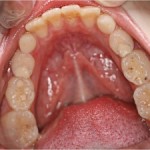
The aim of this cluster randomised controlled trial was to measure the effectiveness of fluoride varnish as a public health intervention to prevent caries in the first permanent molars of 7- and 8-year-old children when delivered in the school setting.
Schools that agreed to participate were randomized into test and reference groups by the study statistician, using computer-generated random numbers, stratified by the locality of the school and the size of the school. The intervention consisted of one drop (0.1 mL) of fluoride varnish per arch applied to the first permanent molars 3 times a yr over a three-year period. Initial applications were conducted by a dentist with subsequent applications by dental therapists.
The primary outcome measure was DFS increment in the first permanent molars; secondary outcome measures were DFT increment and the presence or absence of caries in any of the first permanent molars. 190 (92%) of available schools were randomized with 3133 (50.8%) of the children providing consent. In all 1276 children in the test and 1328 in the reference groups had both baseline and follow-up examinations. (60.2%) children received all 9 applications, and 1342 (90%) received 6 or more applications.
They found
- The DFS increment was 0.65 (SD 2.15) in the test and 0.67 (SD 2.10) in the reference groups, respectively. There was no statistically significant difference between the groups.
The authors concluded
We could find no evidence of a caries preventive benefit of 22,600 ppm fluoride varnish applied to the first permanent molar teeth in the school setting.
Milsom KM, Blinkhorn AS, Walsh T, Worthington HV, Kearney-Mitchell P, Whitehead H, Tickle M. A cluster-randomized controlled trial: fluoride varnish in school children. J Dent Res. 2011 Nov;90(11):1306-11. Epub 2011 Sep 15. PubMed PMID: 21921250.
Comment
The Cochrane Systematic review by Marinho et al (2002) which included a meta-analysis of 7 trials found a D(M)FS pooled prevented fraction estimate of 46% (95%CI, 30% to 63%; p < 0.0001). So it is perhaps surprising that this large public health intervention study found no evidence of effect. There are currently large trials underway in the Northern Ireland (Tickle et al 2011) and Wales (Chestnutt et al) and no doubt others, that are assessing the effectiveness of fluoride varnish so it would be premature at this point to suggest that it is ineffective. Particularly when a number of other randomised controlled trials that have been published since the Cochrane review that have found fluoride varnish beneficial. It is hoped that this new data will be of sufficient quality to be included in the next update of the Cochrane Fluoride varnish review in order to improve our understanding of its effectiveness.
Marinho VCC, Higgins JPT, Logan S, Sheiham A. Fluoride varnishes for preventing dental caries in children and adolescents. Cochrane Database of Systematic Reviews 2002, Issue 1. Art. No.: CD002279. DOI: 10.1002/14651858.CD002279.
Tickle M, Milsom KM, Donaldson M, Killough S, O’Neill C, Crealey G, Sutton M, Noble S, Greer M, Worthington HV. Protocol for Northern Ireland Caries Prevention in Practice Trial (NIC-PIP) trial: a randomised controlled trial to measure the effects and costs of a dental caries prevention regime for young children attending primary care dental services. BMC Oral Health. 2011 Oct 10;11:27. PubMed PMID: 21985746; PubMed Central PMCID: PMC3196725.

Great, thanks for sharing this post.Much thanks again. Great.